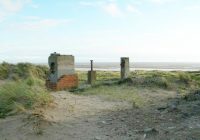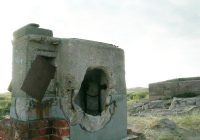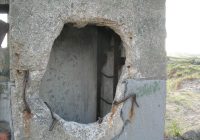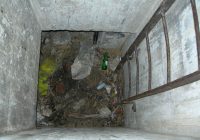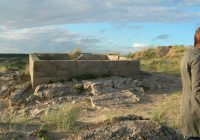A Cold War Bunker in Formby
Jack Gore – Aug 2008
A while ago, I was out walking on the dunes at Ravenmeols and somebody said ‘There’s the wartime observation post.’ I replied that what we were looking at were the remains of a much more recent structure, built in the 1960s as a fully equipped nuclear fallout shelter, ready for World War Three. How did I know this? Well, my interest goes back to 1961 when, as a schoolboy in Watford, I attended an Open Day at a newly built Royal Observer Corps Sector Operations Centre. I was fascinated by the place and its sinister purpose and still retain an interest in bunkers and underground sites.
The Royal Observer Corps (ROC) was first formed in 1925 to identify and monitor enemy aircraft. In 1955 they were given new responsibility for reporting nuclear bursts and monitoring radioactive fallout. 1,563 posts were constructed, reporting to 31 larger Operations Centres (our Centre was near Preston). Each post consisted of an underground room 15ft by 8ft, manned by three people. In the emergency period of an imminent conflict, they would descend the vertical ladder and lock themselves in, with enough food and water for just a few weeks.
When the Bomb dropped, the pressure wave would be measured on the dial of the Bomb Power Indicator; the fireball would burn a mark on sensitized paper in the Ground Zero Indicator (which was outside – unfortunately one of them would have to go up and collect it) and the radioactivity levels in the air would be shown on the Fixed Survey Meter. These results would be telephoned to the Operations Centre where the explosions would be plotted, the likely damage from fallout predicted in conjunction with the meteorologists and the appropriate information given to the ‘Authorities’ or what was left of them. Incidentally, the term ‘Ground Zero’ originated back then, to describe the point, on the surface, immediately below a nuclear detonation – in practice these bombs are often exploded thousands of feet above the target.
The aircraft recognition role of the ROC was discontinued in 1962; the nuclear threat lessened and in 1968 the Corps was reduced from 25,000 to 12,500 personnel. Regular training and exercises took place through the 70s and 80s and finally, in 1991 the ROC ceased active training and the last posts were closed. Many have been bought by farmers or landowners and a small number have been preserved.
What of the Formby post? Well, it was built in 1962 next to a wartime observation platform which can also still be seen. Soon, however, erosion caused the structure to become vulnerable to potential bomb blast damage and, despite efforts to reinforce it, it was closed around 1966-68 and replaced by a new one built at Woodvale, on the aerodrome perimeter near the by-pass. That post remained operational until September 1991 when its surface structures were demolished. The Formby post is very dilapidated; although the entrance and ventilation shafts are still there, the room itself is half-full of rubble.
It is chilling to contemplate what the likely scenario would have been. Experts predicted that the initial strike would have been from a very large weapon, probably in a low-level satellite about two to three hundred miles above the North Sea. There would be little physical damage but the resulting electromagnetic pulse would stop all electronic devices in the UK and most of Western Europe. Radios, watches, cars, communications, industry, power supplies, hospitals and essential services would be instantly crippled. Then the first salvo of missiles would disable all UK military sites, with a total estimated force of 80 megatons. This would be followed by 130 megatons distributed over population centres. Merseyside was one of the prime targets and one would envisage perhaps an air-burst at 5000 feet of a five to ten-megaton weapon.
This would be the effect here in Formby:
A fireball ten thousand feet across would send a flash of heat and light sufficient to set fire to vegetation and cause blindness and severe skin burns to anyone in the way. Immediately, everything within three miles of Liverpool city centre would disappear. Curiously, the blast wave would take at least half a minute to reach here but then, travelling at several hundred miles an hour, it would flatten the already blazing pinewoods, and effectively demolish every building but the very strongest. In this area there would be almost complete fatalities and across the UK, twenty million would have perished within an hour, millions more each following day. Those left alive would have little chance of survival as rain and wind brought the effects of radioactive fallout to a devastated landscape. Years later, the millions of tons of soot, dust, ash and pulverised cities released into the upper atmosphere would have affected the Ozone layer so much as to bring another Ice Age to the planet – the so-called ‘nuclear winter’.
And to think we came so close – the Cuban Missile Crisis of 1962 could so easily have triggered ‘Mutually Assured Destruction’ (another grim catchphrase of the period) had not the diplomatic skills of Kennedy and Khrushchev averted the unthinkable by agreeing to a mutual removal of each other’s missile sites. As recently as 1995, a joint Norway/US research rocket launched from a remote Norwegian island caused a full scale alert in Moscow, with Boris Yeltsin ready to open the black briefcase containing the firing codes. He had eight minutes to decide whether to retaliate but, as the missile site commanders stood by in readiness, they saw on their radar that the rocket was falling harmlessly towards the sea and the threat was averted.
We can all derive enormous comfort from the fact that the bunker at Formby was never used for the purpose for which it was designed.

